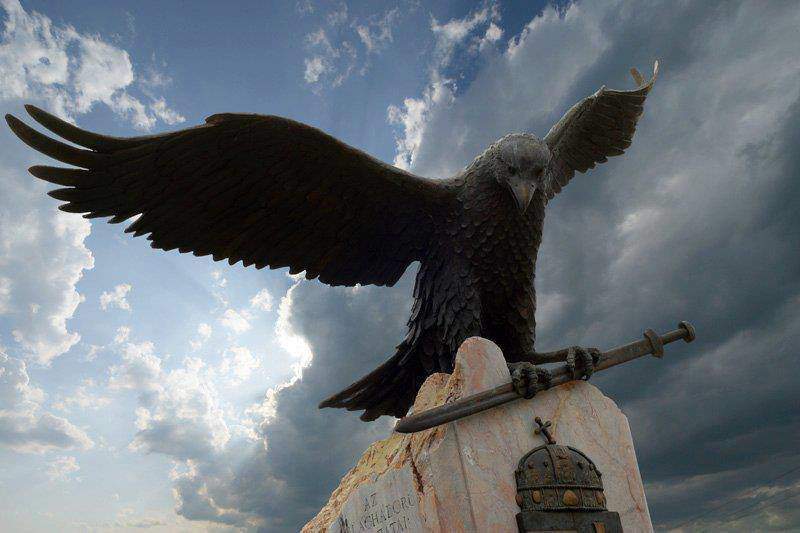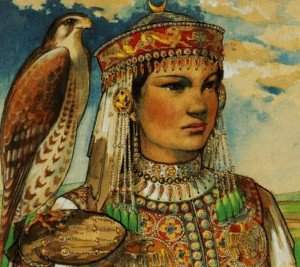Turul, the mystical Hungarian mythological bird

One of the most stunning and mystical symbols in Hungarian mythology is the turul bird. The origin of this legendary bird goes back to prehistoric Hungary. It is the relic of ancient Hungarian faith, the embodiment of the superior powers as well as the monarchical sovereignty. It is also the ancient symbol of national identity and togetherness. Furthermore, it symbolises the Holy Spirit that guarded Hungarians in ancient times.
This mystical bird is still very close to Hungarians’ hearts. The turul is a popular figure in Hungarian folklore; however, it is unclear whether it actually exists/existed in nature. Legends have it that the bird played an important role in the birth of the Turul clan, a Hungarian dynasty which was later mistakenly called Árpád clan. The depiction of the bird also aimed to emphasise the divine origins of all the succeeding kings of this dynasty.
Turul.info, a website that aims to collect all the information regarding early Hungarian history, presents many written pieces about the time when the Magyars conquered the Carpathian Basin in 896 AD as well as the following centuries. This era is not really part of today’s historic public consciousness. The website goes into fascinating details on the legend of the turul as well. We also wanted to present our readers a short overview.
Getting back to the mythological bird, the story of the Turul dynasty’s foundation is rather ambiguous. According to legends, ancient chronicles and folklore tales, the dynasty can be traced back to Nimród, the first Hungarian king who ruled after the flood. Álmos, ruler of the Hungarian tribes, and his offsprings were very proud to tie their origin to Attila, ruler of the Huns, and the Turul clan. Their myths had been preserved by the chroniclers for centuries to come.

The Turul myth, also called Emese’s dream is one of the oldest Hungarian folk tales. Its birth originates back to 860-870 AD. As the myth of the Turul dynasty (Árpád dynasty) was unconditionally believed to be genuine, it was even written into the Chronicon Pictum, a medieval illustrated chronicle from the second half of the fourteenth century. Even though the date of the first written publication of the myth is unclear, it is known that the text that appears in the Chronicon Pictum was based on an earlier source and was noted down by Anonymus, the notary and chronicler of Béla III., 12th-century Hungarian king. Interestingly, nearly all Hungarian people have heard about one of the many titles of the myth, but the word ‘turul’ does not appear in either of the stories. This is just one mystery surrounding the legend.
According to the myth, Emese was the wife of Ügyek (Ügek) and the mother of Álmos, the head of one of the 7 Hungarian tribes who led their people to the Carpathian Basin, where Hungary stands now. The turul bird emerged in her dream in which there was a river flowing from Emese’s uterus that expanded into a foreign land. The dream was interpreted in a way that she was going to give birth to a boy, who would then lead his nation from their homeland, Levédia to a new prosperous country. It was also forecasted that his son’s offsprings would become glorious kings.
But what kind of bird the turul was? Turul.info writes that historians still cannot settle on one opinion. Of course, the bird’s mythological origin does not exclude the chance that it actually exists/existed in nature. All historians agree on the fact that it was a predatory bird, but they cannot seem to be able to determine the exact species. The most plausible theory says that it was a falcon; however, there were many predatory birds in the region where our ancestors lived. Therefore, the mystery remains unsolved.
Even though uncertainties persist regarding the existence of the bird, linguists can exactly pinpoint the origin of the word ‘turul’. According to scholars, the word is of Turkish origin and comes from ‘togrul/ tugrul’ which means ‘gerfalcon’ and ‘the favourite predatory bird with excellent characteristics’.
No matter the changing times, every nation needs legends and myths to believe in.
“Long live the Hungarians, never let them fall!
The turul bird guards its nation and defends them from all.”
Photos: www.turul.info, www.kurultaj.hu
Copy editor: bm
Source: Daily News Hungary


LONG LIVE OUR BEAUTIFUL FATHERLAND!!! GOD BLESS ALWAYS. LOVE. CORVINUS FAMILY
We reiterate
with thanks from Australia
Hungary is, and has been, a magnificent jewel in the history of nations. Good luck and blessings upon you all. May you remain strong and stronger.
As a Taoist/Shamanist, I´d like to thank you from the bottom of my heart for this wonderful posting! Köszönöm szépen!!!
what about the year it came to be
ugly parrot
ARPAD is frequently mentioned in the Old Testament and in Assyrian writings. The ancient city in Syria, is today, Tall Rif at.
In Bible stories and religious classics>e-book; Arpaxhad, Arpacsad is Shem’s son and grandson of Noah. Born 2 years after the floods. Progenitor of Ura and Kesed.
In another writing, he was the king of the Medes. The later Hungarian kings of the House of Arpad may originate from these Chaldean, Medes, Babylonian times.
ARPAD gyakran emlitett az Old Testamentum-ban es az Assyriai irasokban. Az okori varos Syriaban, most Tall Rif-at. A Bibliai tortenetek es vallasos classicusok>e-bbok; Arpaxhad vagy Arpacsad, a Shem fia es Noah unokaja. 2 evvel az arviz utan szuletett. Ura es Kesed elodje. Egy masik irasban, o volt a Medesek kiralya. A kesobbi Magyar Arpadhazi kiralyok, lehetseges eredete a Chaldeai, Medes es Babyloniai idokbol szarmazik.
propably it is same with Tughrul bird in Turkic mythology
@cheyenne – “your ugly”….I love my Hungarian rich history, and will defend it no matter!!!
The Magyars lived in the vicinity of Semuria,(Sumer). When the Hebrew Semite people over took the region, the Sumerians were escaping to that part of Asia. I wonder if this is co-incidence that most of the cities towns name means something in Magyar( Hungarian). Kush, Kish, Lugash( Lagash),ZEGURA, ( SkyLord) Ur, Uruk..